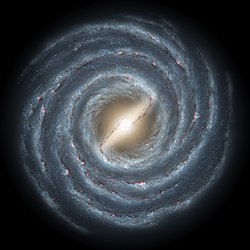Coma-Berenices-Zwerggalaxie
| Galaxie Coma-Berenices-Zwerggalaxie[1] | |
|---|---|
| Coma-Berenices-Zwerggalaxie | |
| AladinLite | |
| Sternbild | Haar der Berenike |
| Position Äquinoktium: J2000.0, Epoche: J2000.0 | |
| Rektaszension | 12h 26m 59s[1] |
| Deklination | 23° 55′ 09″ [1] |
| Erscheinungsbild | |
| Morphologischer Typ | dSph [2] |
| Helligkeit (visuell) | 14,5 ± 0,5 mag [2] |
| Winkelausdehnung | 11,8′ [2] |
| Physikalische Daten | |
| Zugehörigkeit | Lokale Gruppe |
| Entfernung | (143.000 ± 13.000) (137.000 ± 5.000) Lj / (44.000 ± 4.000) (42.000 ± 2.000) pc [2][3] |
| Geschichte | |
| Entdeckungsdatum | 2006 |
| Katalogbezeichnungen | |
| Com, Coma Dwarf[1] | |
Die Coma-Berenices-Zwerggalaxie, kurz auch Com, ist eine spheroidale Zwerggalaxie im Sternbild Haar der Berenike. Sie wurde im Jahr 2006 in Aufnahmen der Durchmusterung des Sloan Digital Sky Survey entdeckt[2].
Eigenschaften
Größen
Die Galaxie befindet sich in einer Entfernung von etwa 44 kpc zu unserem Sonnensystem und entfernt sich von unserer Sonne mit einer Geschwindigkeit von etwa 98 km/s.[2][4] Sie besitzt eine ellipsoide Form mit einem Achsverhältnis von etwa 5:3 und einen Halblichtradius von 70 pc.[2][5]
Leuchtkraft
Com ist eine der kleinsten und lichtschwächsten Satellitengalaxien unserer Milchstraße (nur Segue 1, Segue 2, Bootes II und Willman 1 sind lichtschwächer)[5]. Die integrale Leuchtkraft entspricht mit einer absoluten Helligkeit von MV = -4,1m in etwa dem 3.700fachen der Sonne, was weniger ist als die Helligkeit der Mehrheit der Kugelsternhaufen[5]. Trotzdem besitzt die Zwerggalaxie aufgrund eines hohen Masse-Leuchtkraft-Verhältnisses von 450 eine Gesamtmasse von etwa 1,2 Millionen Sonnenmassen. Dies impliziert eine für diesen Galaxientyp nicht untypische Dominanz durch Dunkle Materie[4].
Metallizität
Die Sternpopulation der Coma-Berenices-Zwerggalaxie setzt sich hauptsächlich zusammen aus älteren Sternen, die vor mehr als 12 Milliarden Jahren entstanden[2]. Die Metallizität dieser altern Sterngeneration ist entsprechend gering mit [Fe/H] = −2,53 ± 0,45, d. h., sie besitzt nur ein 350stel an Elementen, verglichen mit der Sonne[6].
Die Sterne dieser Zwerggalaxie gehören damit wohl zu den ersten Sternen überhaupt, die sich im Universum gebildet haben. Derzeit ist in dieser Galaxie keine Sternentstehung feststellbar, die untere Messgrenze an neutralem Wasserstoffgas liegt bei 46 M☉[7].
Herkunft
Der Coma Zwerg befindet sich nahe dem Sagittarius-Strom, der sich aus verlorengegangenen Sternen der Sagittarius-Zwerggalaxie zusammensetzt. Dies macht eine frühere physische Verbindung dieser beiden Galaxien wahrscheinlich[8].
Weblinks
Einzelnachweise
- ↑ a b c SIMBAD Astronomical Database. In: Results for Coma Dwarf. Abgerufen am 7. Februar 2010.
- ↑ a b c d e f g h V. Belokurov, Zucker, D. B.; Evans, N. W.; Kleyna, J. T.; Koposov, S.; Hodgkin, S. T.; Irwin, M. J.; Gilmore, G. et al.: Cats and Dogs, Hair and a Hero: A Quintet of New Milky Way Companions. In: The Astrophysical Journal. 654, Nr. 2, 2007, S. 897. doi:10.1086/509718.
- ↑ Ilaria Musella, Ripepi, Vincenzo; Clementini, Gisella et al.: Pulsating Variable Stars in the Coma Berenices Dwarf Spheroidal Galaxy. In: The Astrophysical Journal Letters. 695, Nr. 1, 2009, S. L83–1L87. arxiv:0902.4230. bibcode:2009ApJ...695L..83M. doi:10.1088/0004-637X/695/1/L83.
- ↑ a b J. Simon, Geha, M.: The Kinematics of the Ultra‐faint Milky Way Satellites: Solving the Missing Satellite Problem. In: The Astrophysical Journal. 670, 2007, S. 313. doi:10.1086/521816.
- ↑ a b c N. F. Martin, De Jong, J. T. A.; Rix, H. W.: A Comprehensive Maximum Likelihood Analysis of the Structural Properties of Faint Milky Way Satellites. In: The Astrophysical Journal. 684, Nr. 2, 2008, S. 1075. doi:10.1086/590336.
- ↑ E. N. Kirby, Simon, J. D.; Geha, M.; Guhathakurta, P.; Frebel, A.: Uncovering Extremely Metal-Poor Stars in the Milky Way's Ultrafaint Dwarf Spheroidal Satellite Galaxies. In: The Astrophysical Journal. 685: L43, 2008. doi:10.1086/592432.
- ↑ J. Grcevich, Putman, M. E.: H I in Local Group Dwarf Galaxies and Stripping by the Galactic Halo. In: The Astrophysical Journal. 696, 2009, S. 385. doi:10.1088/0004-637X/696/1/385.
- ↑ V. Belokurov, Walker, M.G.; Evans, N.W. et al.: Segue 2: A Prototype of the Population of Satellites of Satellites. In: Mon. Not. R. Astron. Soc.. 397, Nr. 4, 2009, S. 1748–1755. arxiv:0903.0818. bibcode:2009MNRAS.397.1748B. doi:10.1111/j.1365-2966.2009.15106.x.
Auf dieser Seite verwendete Medien
Caption from NASA: Like early explorers mapping the continents of our globe, astronomers are busy charting the spiral structure of our galaxy, the Milky Way. Using infrared images from NASA's Spitzer Space Telescope, scientists have discovered that the Milky Way's elegant spiral structure is dominated by just two arms wrapping off the ends of a central bar of stars. Previously, our galaxy was thought to possess four major arms.
This artist's concept illustrates the new view of the Milky Way, along with other findings presented at the 212th American Astronomical Society meeting in St. Louis, Mo. The galaxy's two major arms (Scutum-Centaurus and Perseus) can be seen attached to the ends of a thick central bar, while the two now-demoted minor arms (Norma and Sagittarius) are less distinct and located between the major arms. The major arms consist of the highest densities of both young and old stars; the minor arms are primarily filled with gas and pockets of star-forming activity.
The artist's concept also includes a new spiral arm, called the "Far-3 kiloparsec arm," discovered via a radio-telescope survey of gas in the Milky Way. This arm is shorter than the two major arms and lies along the bar of the galaxy.
Our sun lies near a small, partial arm called the Orion Arm, or Orion Spur, located between the Sagittarius and Perseus arms.



